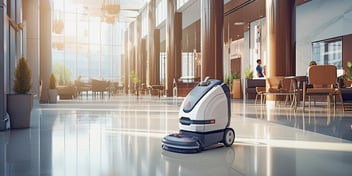Debunking Myths: Cleaning Robots

Autonomous floor-scrubbing cleaning robots have emerged as game-changers in the cleaning industry, promising efficiency and cost-effectiveness in industrial, manufacturing, and other commercial spaces. Despite their potential, several myths have surfaced, hindering their widespread adoption. Throughout this blog, we’ll debunk these misconceptions and explore the transformative benefits of autonomous cleaning solutions.
Myth #1: All cleaning vehicles are the same
Autonomous floor-scrubbing robots are often lumped together with autonomous guided vehicles (AGVs), but significant differences exist. Unlike AGVs, which follow pre-defined paths, autonomous mobile robots (AMRs) dynamically plan routes based on their surroundings. This adaptability allows AMRs to navigate obstacles and adjust cleaning strategies in real time. Additionally, AMRs provide detailed reports on cleaning activities, enhancing transparency and accountability.
Myth #2: It costs more to own a cleaning robot than to hire cleaning personnel
One of the most pervasive myths surrounding autonomous cleaning robots is their perceived high cost. However, a comprehensive analysis of the return on investment (ROI) reveals a different story.
By automating cleaning tasks, robots free up valuable staff time and eliminate the need for manual equipment and its associated maintenance costs. This results in significant savings and efficiency gains for businesses. Furthermore, when factoring in additional expenses such as benefits, training, and liability, the cost-effectiveness of robots becomes even more apparent.
Myth #3: Cleaning robots are difficult to use
Contrary to popular belief, modern autonomous cleaning robots are designed with user-friendliness in mind. They feature intuitive interfaces and on-robot training capabilities, making them easy to operate for cleaning staff. Additionally, advanced robots can adapt to changing environments with minimal human intervention, simplifying cleaning schedules and tasks. With the right technical support, operators can maximize the efficiency of autonomous cleaning robots without extensive training or programming knowledge.
Myth #4: Automated cleaning systems cannot achieve the same level of cleanliness as human cleaning
Another misconception is that autonomous cleaning robots are inferior to human cleaners in terms of cleanliness. However, advancements in robot technology have enabled them to achieve superior cleaning outcomes. Features such as sophisticated navigation capabilities and continuous cleaning ensure that robots maintain high cleanliness standards in dynamic environments. Furthermore, real-time reporting allows businesses to monitor and optimize cleaning performance, ensuring consistent results.
Myth #5: A robot can only move within a designated area
While some cleaning robots require manual programming to follow specific paths, the most advanced models are capable of autonomous navigation. These robots use sophisticated AI algorithms to make real-time driving decisions, adapting to their surroundings without human intervention. This flexibility allows them to easily and efficiently clean a wide range of environments, from warehouses to healthcare facilities.
Myth #6: Cleaning robots are less productive than human workers
Productivity is often cited as a concern when considering autonomous cleaning robots. However, this overlooks the shift in labor allocation that occurs with automation. While robots may have a different square footage per hour metric compared to human cleaners, they eliminate the need for manual labor, freeing up staff to focus on other value-added tasks. By assessing ROI based on overall efficiency and resource utilization, businesses can realize the full potential of autonomous cleaning solutions.
Myth #7: Autonomous cleaning isn’t environmentally friendly
Contrary to popular belief, autonomous floor-scrubbing robots are environmentally friendly alternatives to traditional cleaning methods. By optimizing resource usage and relying on clean energy sources, such as batteries, robots reduce carbon emissions and minimize environmental impact. Additionally, their recyclable components contribute to sustainability efforts, making them a responsible choice for businesses looking to minimize their ecological footprint.
Autonomous cleaning solutions hold immense potential to revolutionize the cleaning industry. By dispelling these myths, businesses can better understand the benefits and consider incorporating such technologies into their operations. Remember, embracing innovation is key to staying ahead in today’s competitive landscape.
Ready to explore how technology can transform your cleaning strategy? Reach out to us today for a consultation tailored to your specific needs. Let’s work together to find the best solutions for your business – fill out the form below!
Commercial Cleaning Tailored to Your Needs
-1.jpg?width=1280&height=1048&name=inx-vacuum%20(edited)-1.jpg)


